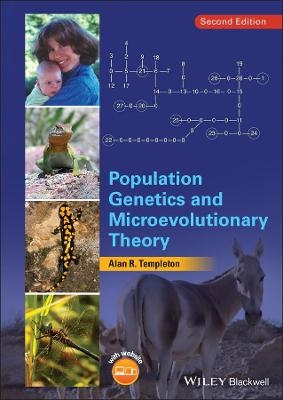
Population Genetics and Microevolutionary Theory
John Wiley & Sons Inc (Verlag)
978-1-118-50423-9 (ISBN)
Building on the success of the first edition, Population Genetics is now revised and expanded with coverage of the exciting new developments in the field, including new discoveries in epigenetics and genome-wide studies. Emphasizing that population structure forms the underlying template upon which quantitative genetics and natural selection operate, the book prepares students to successfully apply population genetics analytical tools by providing a solid foundation in microevolutionary theory.
Population Genetics and Microevolutionary Theory, Second Edition is a must-read for future population and evolutionary geneticists, and for those who will be applying population genetic concepts and techniques in other areas such as genetic epidemiology and conservation biology.
Alan R. Templeton, PhD, is Charles Rebstock Professor Emeritus of Biology and Statistical Genomics at Washington University in St. Louis. His research focus is on the application of molecular genetic techniques and statistical population genetics to a variety of basic and applied evolutionary problems. He is on the editorial boards of Molecular Phylogenetics and Evolution and Evolutionary Bioinformatics Online. A. R. Templeton, Washington University in St. Louis, USA
Preface to the 2nd Edition ix
Chapter 1. The Scope and Basic Premises of Population Genetics 1-1
Basic Premises of Population Genetics 1-1
Population Genomics1-12
Section 1: Population Structure and History
Chapter 2. Modeling Evolution and the Hardy-Weinberg Law 2-1
How to Model Microevolution 2-1
The Hardy-Weinberg Model 2-4
Hardy-Weinberg for Two Loci2-19
Chapter 3. Systems of Mating 3-1
Inbreeding 3-1
Assortative Mating3-25
Disassortative Mating3-45
Chapter 4. Genetic Drift 4-1
Basic Evolutionary Properties of Genetic Drift 4-2
Founder and Bottleneck Effects 4-7
Genetic Drift and Disequilibrium4-11
Genetic Drfit, Disequilibrium, and System of Mating4-13
Effective Population Size4-18
Chapter 5. Genetic Drift in Large Populations and Coalescence 5-1
Newly Arisen Mutations 5-1
Neutral Alleles 5-3
The Coalescent5-22
Chapter 6. Gene Flow and Population Subdivision 6-1
Gene Flow Between Two Local Populations 6-1
The Balance of Gene Flow and Drift 6-6
An Example of the Balance of Drift and Gene Flow6-27
Factors Influencing The Amount and Patter of Gene Flow6-42
Total Effective Population Size in Subdivided Populations6-62
Multiple Modes of Inheritance and Population Structure6-71
Admixture6-76
Identifying Subpopulations and Population Structure6-81
A Final Warning6-96
Chapter 7. Population History 7-1
Inferring Historical Effective Population Sizes 7-6
Inferring Historical Gene Flow Patterns and Admixture 7-11
Using Haplotype Trees to Study Population History 7-19
Model Based Approaches to Phylogeographic Analysis 7-56
Direct Studies Over Space and Past Times 7-70
Historical Population Genetics and Macroevolution 7-75
Section 2: Genotype and Phenotype
Chapter 8. Basic Quantitative Genetic Definitions and Theory 8-1
"Simple" Mendelian Phenotypes 8-2
Nature Versus Nurture? 8-7
The Fisherian Model of Quantitative Genetics8-13
Chapter 9. Quantitative Genetics: Unmeasured Genotypes 9-1
Correlation Between Relatives 9-2
The Distinction Between Heritability and Inheritance9-17
Response to Selection9-19
The Problem of Between-Population Differences in Mean
Phenotype 9-21
Controlled Crosses for the Analysis of Between Population
Differences 9-30
The Balance Between Mutation, Drift, and Gene Flow Upon
Phenotypic Variance 9-36
Chapter 10. Quantitative Genetics: Measured Genotypes 10-1
Marker Association Studies 10-5
Candidate Loci10-35
Candidate Loci and Genetic Architecture10-51
Section 3: Natural Selection and Adaptation
Chapter 11. Natural Selection 11-1
The Fundamental Equation of Natural Selection: Measured
Genotypes 11-4
Sickle-Cell Anemia as an Example of Natural Selection 11-10
Adaptation as a Polygenic Process 11-24
The Fundamental Theorem of Natural Selection: Unmeasured
Genotypes 11-29
Some Implications of the Fundamental Equations of Natural
Selection 11-33
The Course of Adaptation and Natural Selection 11-47
Chapter 12. Interactions of Natural Selection with Other Evolutionary Forces
and the Detection of Natural Selection 12-1
The Interaction of Natural Selection with Mutation 12-3
The Interaction of Natural Selection with Mutation and System of
Mating 12-8
The Interaction of Natural Selection with Gene Flow 12-12
The Interaction of Natural Selection with Genetic Drift 12-21
The Interactions of Natural Selection, Genetic Drift, and
Gene Flow 12-28
The Interactions of Natural Selection, Genetic Drift, and Mutation 12-45
The Interactions of Natural Selection, Genetic Drift, Mutation, and
Recombination 12-65
Candidate Loci 12-71
Quantitative Genetic Approaches to Detecting Selection 12-75
The Neutralist/Selectionist Debate 12-80
Chapter 13. Units and Targets of Selection 13-1
The Unit of Selection 13-4
Targets of Selection Below the Level of the Individual 13-18
Targets of Selection Above the Level of the Individual 13-51
Chapter 14. Selection in Heterogeneous Environments 14-1
Coarse-Grained Spatial Heterogeneity 14-4
Coarse-Grained Temporal Heterogeneity 14-34
Fine-Grained Heterogeneity 14-56
Coevolution 14-74
Chapter 15. Selection in Age-Structured Populations 15-1
Life History and Fitness 15-3
The Evolution of Senescence 15-13
Abnormal Abdomen: An Example of Selection in an
Age-Structured Population 15-24
Overview 15-63
Appendices
Appendix 1. Genetic Survey Techniques A1-1
Appendix 2. Probability and Statistics A2-1
References R-1
Index
| Erscheint lt. Verlag | 5.8.2021 |
|---|---|
| Verlagsort | New York |
| Sprache | englisch |
| Maße | 183 x 261 mm |
| Gewicht | 1730 g |
| Einbandart | gebunden |
| Themenwelt | Naturwissenschaften ► Biologie ► Genetik / Molekularbiologie |
| ISBN-10 | 1-118-50423-2 / 1118504232 |
| ISBN-13 | 978-1-118-50423-9 / 9781118504239 |
| Zustand | Neuware |
| Informationen gemäß Produktsicherheitsverordnung (GPSR) | |
| Haben Sie eine Frage zum Produkt? |
aus dem Bereich


